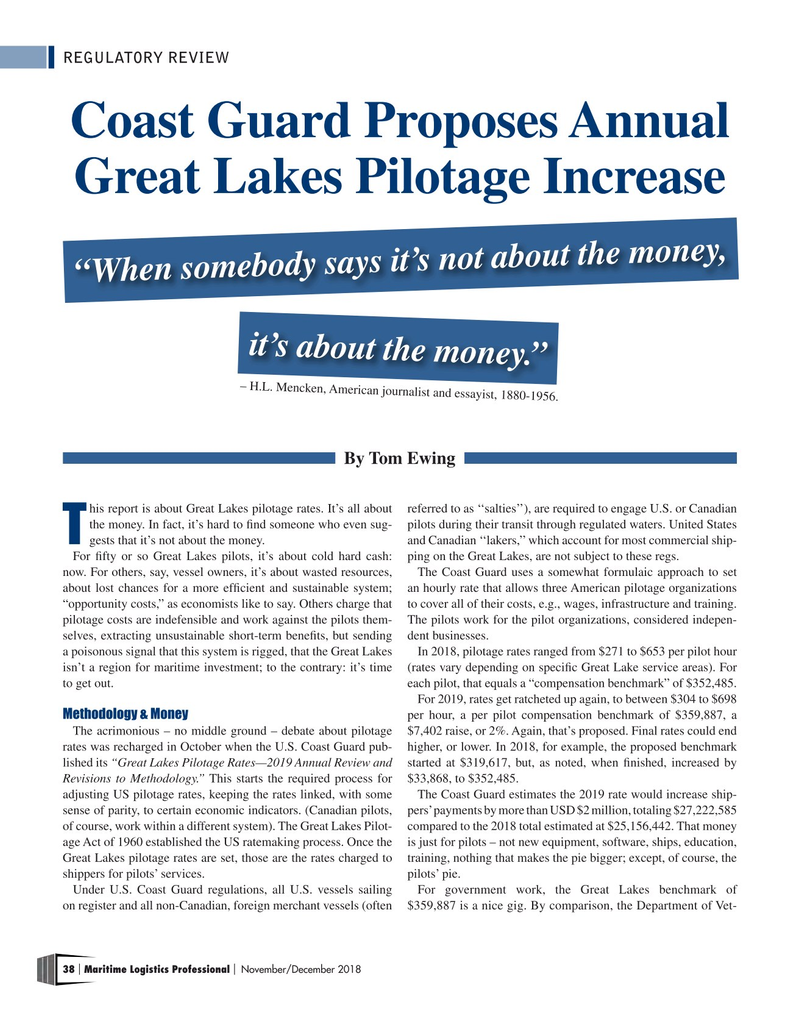
Page 38: of Maritime Logistics Professional Magazine (Nov/Dec 2018)
Regulatory & Environmental Review
Read this page in Pdf, Flash or Html5 edition of Nov/Dec 2018 Maritime Logistics Professional Magazine
REGULATORY REVIEW
Coast Guard Proposes Annual
Great Lakes Pilotage Increase “When somebody says it’s not about the money, it’s about the money.” – H.L. Mencken, American journalist and essayist, 1880-1956.
By Tom Ewing his report is about Great Lakes pilotage rates. It’s all about referred to as ‘‘salties’’), are required to engage U.S. or Canadian the money. In fact, it’s hard to fnd someone who even sug- pilots during their transit through regulated waters. United States
T gests that it’s not about the money. and Canadian ‘‘lakers,’’ which account for most commercial ship-
For ffty or so Great Lakes pilots, it’s about cold hard cash: ping on the Great Lakes, are not subject to these regs.
now. For others, say, vessel owners, it’s about wasted resources, The Coast Guard uses a somewhat formulaic approach to set about lost chances for a more effcient and sustainable system; an hourly rate that allows three American pilotage organizations “opportunity costs,” as economists like to say. Others charge that to cover all of their costs, e.g., wages, infrastructure and training. pilotage costs are indefensible and work against the pilots them- The pilots work for the pilot organizations, considered indepen- selves, extracting unsustainable short-term benefts, but sending dent businesses.
a poisonous signal that this system is rigged, that the Great Lakes In 2018, pilotage rates ranged from $271 to $653 per pilot hour isn’t a region for maritime investment; to the contrary: it’s time (rates vary depending on specifc Great Lake service areas). For to get out. each pilot, that equals a “compensation benchmark” of $352,485.
For 2019, rates get ratcheted up again, to between $304 to $698
Methodology & Money per hour, a per pilot compensation benchmark of $359,887, a
The acrimonious – no middle ground – debate about pilotage $7,402 raise, or 2%. Again, that’s proposed. Final rates could end rates was recharged in October when the U.S. Coast Guard pub- higher, or lower. In 2018, for example, the proposed benchmark lished its “Great Lakes Pilotage Rates—2019 Annual Review and started at $319,617, but, as noted, when fnished, increased by
Revisions to Methodology.” This starts the required process for $33,868, to $352,485.
adjusting US pilotage rates, keeping the rates linked, with some The Coast Guard estimates the 2019 rate would increase ship- sense of parity, to certain economic indicators. (Canadian pilots, pers’ payments by more than USD $2 million, totaling $27,222,585 of course, work within a different system). The Great Lakes Pilot- compared to the 2018 total estimated at $25,156,442. That money age Act of 1960 established the US ratemaking process. Once the is just for pilots – not new equipment, software, ships, education,
Great Lakes pilotage rates are set, those are the rates charged to training, nothing that makes the pie bigger; except, of course, the shippers for pilots’ services. pilots’ pie.
Under U.S. Coast Guard regulations, all U.S. vessels sailing For government work, the Great Lakes benchmark of on register and all non-Canadian, foreign merchant vessels (often $359,887 is a nice gig. By comparison, the Department of Vet- 38 Maritime Logistics Professional November/December 2018 | |

 37
37

 39
39
